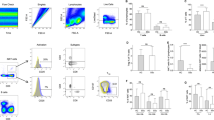Abstract
Viral infection has been assigned some role in the pathogenesis of Behçet's disease (BD). Defects in natural killer (NK) cell repertoire may be involved in impaired antiviral immunity, leading to the development of BD. We studied killer inhibitory receptor (KIR) expression in 40 patients with BD. CD94 and CD158b expression of NK cells was normal in a great majority of BD patients. NKB1 expression was reduced in eight and increased in six. Twelve of these 14 patients (86%) had severe eye disease. Some had reduced NKB1 and enhanced CD158a expression simultaneously, or enhanced NKB1 and reduced CD158a simultaneously, suggesting a skewed NK cell repertoire in BD. Collectively, KIR expression was abnormal in the BD patients with severe eye disease. This may result from genetic predisposition, or certain viruses may affect the KIR repertoire formation in BD patients. Abnormal KIR expression of NK cells may be associated with the development of BD.

Similar content being viewed by others
References
Sakane T, Takeno M, Suzuki N, Inaba G (1999) Behçet's disease. N Engl J Med 341:1284–1291
Gul A, Hajeer AH, Worthington J, Ollier WE, Silman AJ (2001) Linkage mapping of a novel susceptibility locus for Behçet's disease to chromosome 6p22-23. Arthritis Rheum 44:2693–2696
Eglin RP, Lehner T, Subak-Sharpe JH (1982) Detection of RNA complementary herpes simplex virus in mononuclear cells from patients with Behçet's syndrome and recurrent oral ulceration. Lancet ii:1356–1360
Lehner T (1967) Behçet's syndrome and autoimmunity. Br Med J 1:465–467
Kaneko S, Suzuki N, Yamashita N, et al (1997) Characterization of T cells specific for an epitope of human 60-kD heat shock protein (hsp) in patients with Behçet's disease (BD) in Japan. Clin Exp Immunol 108:204–212
Suzuki N, Bianchi E, Bass H et al (1990) Natural killer lines and clones with apparent antigen specificity. J Exp Med 172:457–462
Biron CA, Nguyen KB, Pien GC, Cousens LP, Salazar-Mather TP (1999) Natural killer cells in antiviral defense: function and regulation by innate cytokines. Annu Rev Immunol 17:189–220
Mandelboim O, Lieberman N, Lev M et al (2001) Recognition of haemagglutinins on virus-infected cells by NKp46 activates lysis by human NK cells. Nature 409:1055–1060
Long EO, Rajagopalan S (2000) HLA class I recognition by killer cell Ig-like receptors. Semin Immunol 12:101–108
Raulet DH (2000) Development and tolerance of natural killer cells. Curr Opin Immunol 11:129–134
Cerwenka A, Lanier LL (2001) Ligands for natural killer cell receptors: redundancy or specificity. Immunol Rev 181:158–169
Uhrberg M, Valiante NM, Shun BP et al (1997) Human diversity in killer cell inhibitory receptor genes. Immunity 7:753–763
Gumperz JE, Litwin V, Phillips JH, Lanier LL, Parham P (1995) The Bw4 public epitope of HLA-B molecules confers reactivity with natural killer cell clones that express NKB1, a putative HLA receptor. J Exp Med 181:1133–1144
Gardiner CM, Guethlein LA, Shilling HG et al (2001) Different NK cell surface phenotypes defined by the DX9 antibody are due to KIR3DL1 gene polymorphism. J Immunol 166:2992–3001
Hamzaoui K, Ayed K, Slim A, Hamza M, Touraine J (1990) Natural killer cell activity, interferon-gamma and antibodies to herpes viruses in patients with Behçet's disease. Clin Exp Immunol 79:28–34
Kaneko F, Takahashi Y, Muramatsu R et al (1985) Natural killer cell numbers and function in peripheral lymphoid cells in Behçet's disease. Br J Dermatol 113:313–318
Eksioglu-Demiralp E, Direskeneli H, Ergun T, Fresko I, Akoglu T (1999) Increased CD4+CD16+ and CD4+CD56+ T cell subsets in Behçet's disease. Rheumatol Int 19:23–26
Acknowledgements
This work was partially supported by a grant from the Behçet's Disease Research Committee of the Department of Health, Labour, and Welfare of Japan, a 2001 grant in aid for scientific research projects from the Ministry of Education, Culture, Sports, and Technology of Japan, 2001 special coordination funds of the Japanese Ministry of Education, Culture, Sports, and Technology, and a grant from the SRF Foundation.
Author information
Authors and Affiliations
Corresponding author
Rights and permissions
About this article
Cite this article
Takeno, M., Shimoyama, Y., Kashiwakura, JI. et al. Abnormal killer inhibitory receptor expression on natural killer cells in patients with Behçet's disease. Rheumatol Int 24, 212–216 (2004). https://doi.org/10.1007/s00296-003-0352-x
Received:
Accepted:
Published:
Issue Date:
DOI: https://doi.org/10.1007/s00296-003-0352-x




